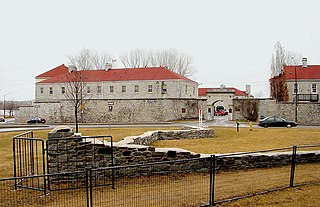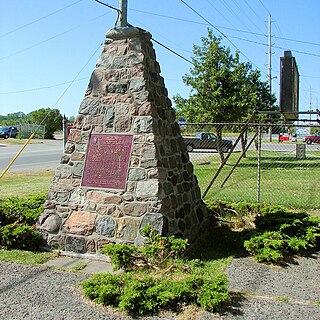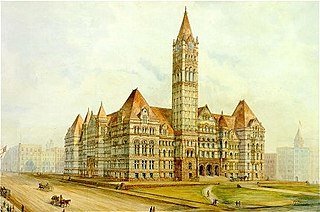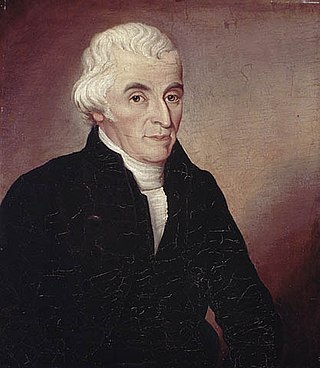Related Research Articles

Lake Ontario is one of the five Great Lakes of North America. It is bounded on the north, west, and southwest by the Canadian province of Ontario, and on the south and east by the U.S. state of New York. The Canada–United States border spans the centre of the lake.


Kingston is a city in Ontario, Canada. It is located on the north-eastern end of Lake Ontario, at the beginning of the St. Lawrence River and at the mouth of the Cataraqui River. The city is midway between Toronto, Ontario and Montreal, Quebec. Kingston is also located nearby the Thousand Islands, a tourist region to the east, and the Prince Edward County tourist region to the west. Kingston is nicknamed the "Limestone City" because of the many heritage buildings constructed using local limestone.

The Mississaugas are a group of First Nations peoples located in southern Ontario, Canada. They are a sub-group of the Ojibwe Nation.
King's Highway 33, commonly referred to as Highway 33 or Loyalist Parkway, is a provincially maintained highway in the Canadian province of Ontario. The route begins at Highway 62 in Bloomfield and travels east to the Collins Bay Road junction at Collins Bay in the city of Kingston, a distance of 60.9 kilometres (37.8 mi). The highway continues farther east into Kingston as Bath Road, ending at the former Highway 2, now Princess Street. Highway 33 is divided into two sections by the Bay of Quinte. The Glenora Ferry service crosses between the two sections just east of Picton, transporting vehicles and pedestrians for free throughout the year.

Fort Henry National Historic Site is located in Kingston, Ontario, Canada on Point Henry, a strategic, elevated point near the mouth of the Cataraqui River where it flows into the St. Lawrence River at the east end of Lake Ontario. The fort and the point on which the fort was built were named after Henry Hamilton, former Lieutenant-Governor of the Province of Quebec.

Six Nations is demographically the largest First Nations reserve in Canada. As of the end of 2017, it has a total of 27,276 members, 12,848 of whom live on the reserve. It is the only reserve in North America that has representatives of all six Haudenosaunee nations living together. These nations are the Mohawk, Cayuga, Onondaga, Oneida, Seneca and Tuscarora. Some Lenape also live in the territory.

Fort Frontenac was a French trading post and military fort built in July 1673 at the mouth of the Cataraqui River where the St. Lawrence River leaves Lake Ontario, in a location traditionally known as Cataraqui. It is the present-day location of Kingston, Ontario, Canada. The original fort, a crude, wooden palisade structure, was called Fort Cataraqui but was later named for Louis de Buade de Frontenac, Governor of New France who was responsible for building the fort. It was abandoned and razed in 1689, then rebuilt in 1695.
The Hon. Richard Cartwright was a businessman, judge and political figure in Upper Canada.

Deseronto is a town in the Canadian province of Ontario, in Hastings County, located at the mouth of the Napanee River on the shore of the Bay of Quinte, on the northern side of Lake Ontario.

Carrying Place is a community straddling the Quinte West and Prince Edward County border that serves as a gateway to Prince Edward County, Ontario, Canada. Situated northwest of Picton and just south of Trenton, it was named for its location on the portage between the Bay of Quinte and Weller's Bay on Lake Ontario. The Loyalist Parkway passes through the community.

The Toronto Purchase was the sale of lands in the Toronto area from the Mississaugas of New Credit to the British crown. An initial, disputed, agreement was made in 1787, in exchange for various items. The agreement was revisited in 1805, intended to clarify the area purchased. The agreement remained in dispute for over 200 years until 2010, when a settlement for the land was made between the Government of Canada and the Mississaugas for the land and other lands in the area.

The Haldimand Proclamation was a decree that granted land to the Mohawk who had served on the British side during the American Revolution. The decree was issued by the Governor of the Province of Quebec, Frederick Haldimand, on October 25, 1784, three days after the Treaty of Fort Stanwix was signed between others of the Six Nations and the American government. The granted land had to be purchased from the Mississaugas of the Credit whose traditional territory spans much of modern day Southwestern Ontario. On May 22, 1784 Col. John Butler was sent to negotiate the sale of approximately 3,000,000 acres of land located between Lakes Huron, Ontario, and Erie for £1180.00 from the Mississaugas of the Credit. Of the land ceded, some 550,000 acres were granted to the Mohawk nation in the Haldimand Proclamation. The sale by the Mississaugas of the Credit is also referred to as the "Between the Lakes Treaty."
Carleton Island is located in the St Lawrence River in upstate New York. It is part of the Town of Cape Vincent, in Jefferson County.

Alderville First Nation is a band of Mississaugas, a sub-nation of the Ojibways. The Alderville and Sugar Island 37A reserves belong to that First Nation band government.
The history of Ottawa, capital of Canada, was shaped by events such as the construction of the Rideau Canal, the lumber industry, the choice of Ottawa as the location of Canada's capital, as well as American and European influences and interactions. By 1914, Ottawa's population had surpassed 100,000 and today it is the capital of a G7 country whose metropolitan population exceeds one million.
Point Frederick is a 41-hectare (101-acre) peninsula in Kingston, Ontario, Canada. The peninsula is located at the south end of the Rideau Canal where Lake Ontario empties into the St. Lawrence River. Point Frederick is bounded by the Cataraqui River to the west, the St. Lawrence River to the south, and Navy Bay to the east. The peninsula is occupied by the Royal Military College of Canada (RMC). Several of the buildings located on Point Frederick and the site of the old naval dockyard are national historic sites. Fort Frederick, at the south end of the peninsula, is a feature of the Kingston Fortifications National Historic Site of Canada.
Captain Michael Grass (c.1734–1813) was a French-born militia captain who was loyal to the British and led a contingent of United Empire Loyalists to Canada after the American War of Independence. Grass was one of the founders of Kingston, Ontario.

John Stuart was a Church of England clergyman, missionary, educator, and Loyalist. He is noted for being the first chaplain of the Legislative Council of Upper Canada, for being the first Anglican priest in what is now Ontario, for building the first church in what is now Kingston, Ontario, and for opening the first grammar school in Upper Canada.

John Ross was a British Army officer in the French and Indian War and the American Revolution. He is best known for commanding a mixed force of approximately 600 regulars, Loyalists, and Indians in a raid into upstate New York on October 24, 1781 that culminated in the Battle of Johnstown, one of the last battles in the northern theater of the American Revolution. After the war, Ross was instrumental in settling Loyalist refugees in what is now the Kingston area of eastern Ontario.
References
- Notes
- Bibliography
- Mika, Nick and Helma et al. Kingston, Historic City. Belleville: Mika Publishing Co., 1987. ISBN 0-921341-06-7.
- Osborne, Brian S. and Donald Swainson. Kingston, Building on the Past for the Future. Quarry Heritage Books, 2011. ISBN 1-55082-351-5
- Crawford Purchase National Historic Event Retrieved 2015-09-11
- Willes, Frances Mary (2014). A study to examine the boundary expansions of Kingston from a legal and land perspective, with emphasis on the 1998 amalgamation (PDF) (Thesis). Queen's University . Retrieved September 14, 2015.